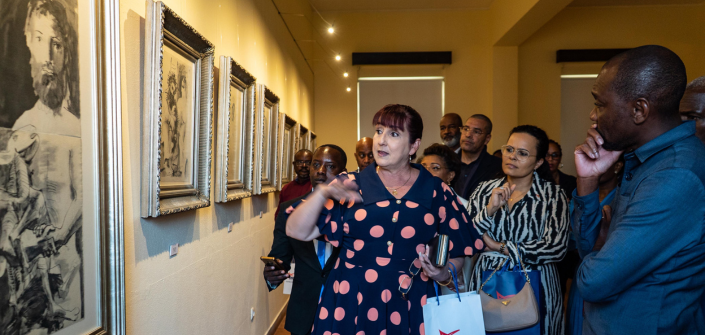The Cultural Work of the European University of the Atlantic (UNEATLANTICO) and the Ibero-American University Foundation (FUNIBER), in collaboration with the Universidade Internacional do Cuanza (UNIC) and the Spanish Embassy in Angola, recently inaugurated the exhibition “The Burial of the Count of Orgaz and the Double Flute”, by the artist Pablo Picasso, in the province of Huíla (Angola).
The event, held at the Instituto Superior de Ciências da Educação (ISCED) in Lubango, also had the support of the Government of Huíla, the transport company AJS and ENSA Seguros de Angola. At the opening ceremony, the guests were welcomed with speeches of thanks given by Dr. Maria Rodrigues, UNIC’s vice-rector of the scientific area, Dr. Hélder Bahu, ISCED’s president, and Dr. Matilde Guebe, ENSA’s executive administrator. The exhibition was officially inaugurated by Mr. Bernabé Mahapi Dala, Governor of the province of Huíla.
Before entering the room where the works were displayed, the guests were asked to draw some lines on a canvas provided by the organization in order to stimulate creativity in the creation of a joint work by all the guests.
One of the collections, “The Burial of the Count of Orgaz”, emerged as a visual part of a surrealist experiment in automatic writing carried out by Picasso on a Spanish manuscript from 1957 and 1958, and a proposal by the poet Rafael Alberti through a poetic text in which he praised the creativity of the Spanish artist. In the collection “The Double Flute”, Picasso cultivates the academic nude, without showing male or female sexual organs, with remarkable realism, but also recreating characters from Greco-Roman mythology such as the faun, the minotaur and the god Bacchus.
With the free exhibition of these collections, from August 13 to September 7 at the Instituto Superior de Ciência de Educação (ISCED), Angolans are offered the possibility of enjoying these collections of such a universal artist. The works will remain in Angola for approximately one year. In addition to having been previously exhibited in Luanda, they will also be exhibited in the provinces of Bié, Huambo, Benguela and finally again in Luanda, where they will be closed.


